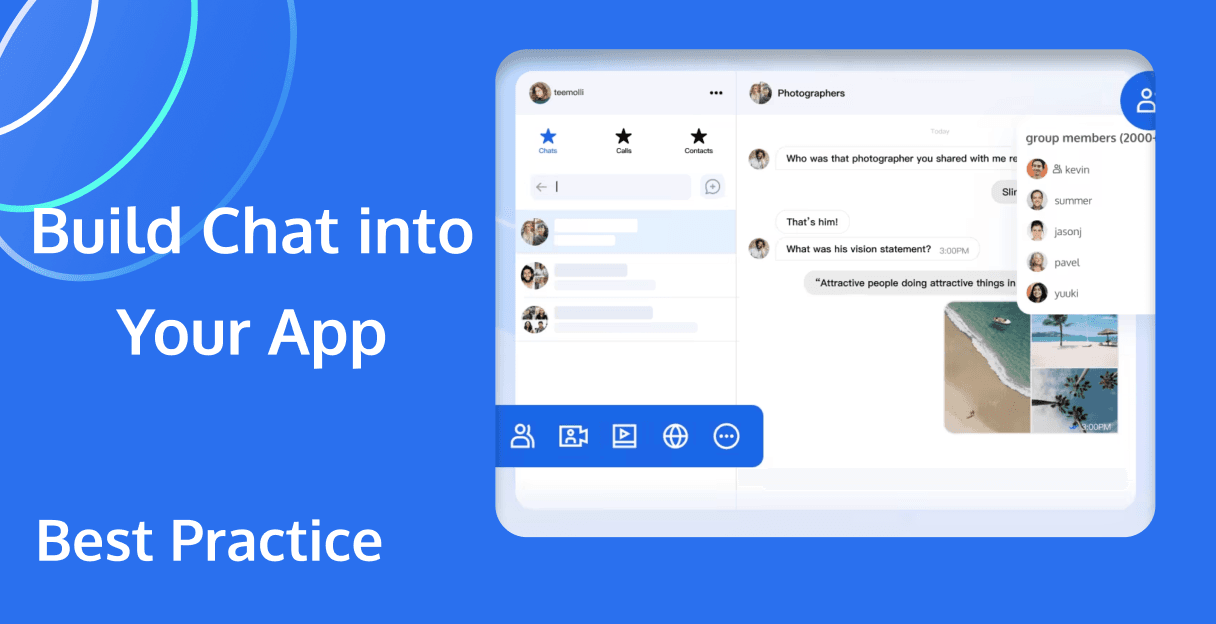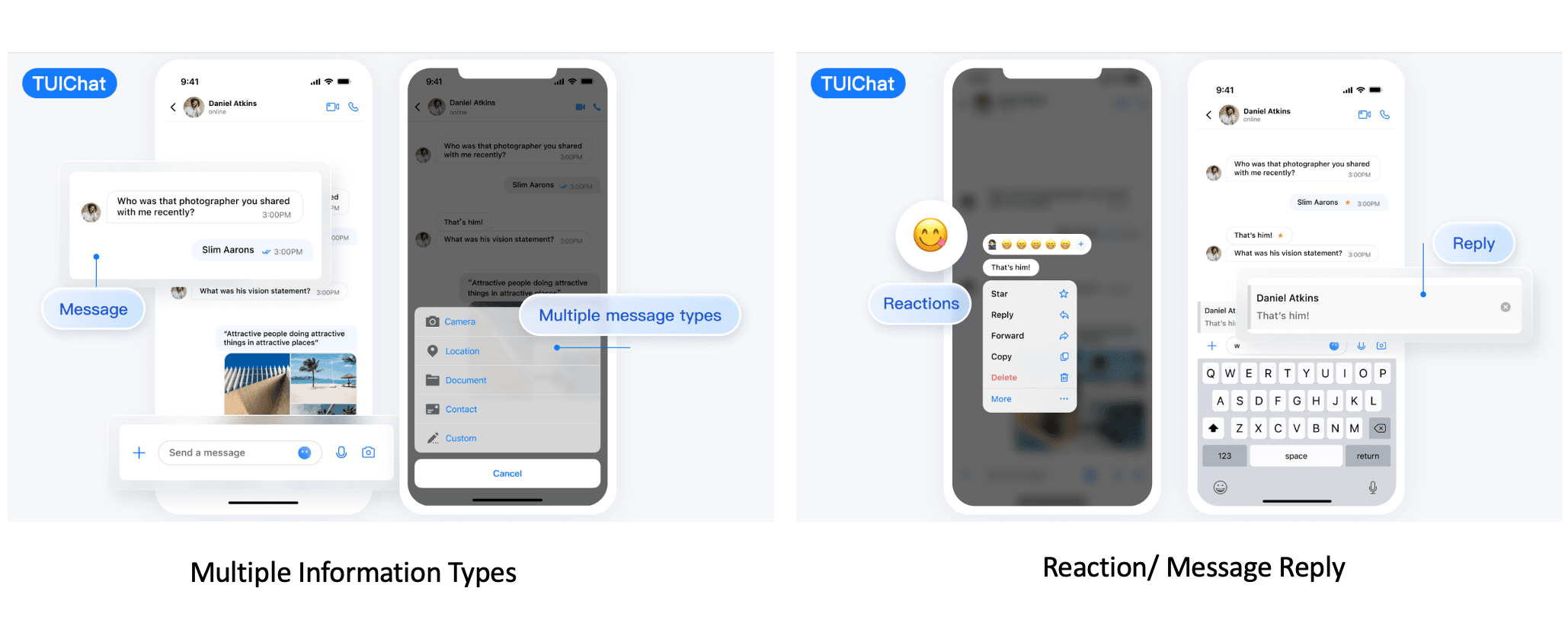
Achieving a stable, efficient, secure, and user-friendly chat system requires developers to follow certain best practices. From initialization and login to message management and performance optimization, every step is critical. This guide will provide a detailed overview of how to integrate chat functionality into your application, covering best practices for error handling, security, scalability, and user feedback, to help you create an exceptional chat experience.
Key Features for an Effective Chat Tool
To implement these best practices, you might need a chat tool with the following features:
Support Various Message Types
Supports text, images, audio, and video messages. Audio is suitable for time-saving voice messages, and video is perfect for demonstrations or showcasing features.
Group Management
- Create Groups: Create dedicated groups for different projects or teams, such as "Marketing Team" or "Product Development Team."
- Manage Group Members: Add or remove members to ensure the group consists of relevant personnel.
- Customize Profiles: Each group member can set their own avatar and nickname for easy identification.
- Rich Group Types: Support for live broadcast groups, regular groups, and community-style groups like Discord.
- Advanced Management Features: Set administrator permissions, @ specific members, mute certain members, etc.
Conversation and Notification Management
- View Unread Messages: Check all unread messages after work to ensure nothing is missed.
- Pin or Delete Chats: Pin important chats to the top or delete chats no longer needed.
- Offline/Online Push Notifications: Receive important notifications even when not in the app. For instance, a push notification alerts you to handle an urgent customer request.
- Message Recall: Recall mistakenly sent messages to avoid misunderstandings.
- Multi-device Sync: Ensure message synchronization across different devices to continue conversations anytime, anywhere.
- Read Receipts: Confirm whether the other party has read your message.
- Message Search: Quickly find past conversation content using keywords.
- Unread Count: Display the number of unread messages to help you stay on top of things.
User Relationship Management
- Add Friends: Build closer team relationships.
- User Search: Quickly find specific users for easy contact.
- Blacklist Feature: Block unnecessary contacts to keep the work environment clean.
- User Profile Settings: Each user can set detailed profiles, including avatars, for easy identification and contact.
- Friend Requests and Grouping: Manage friend requests and group friends for easier management and communication. For example, create "Colleagues" and "Clients" groups for categorized management.
Data Statistics
- Data Dashboard: Monitor chat activity in real-time, such as the number of current online users and user activity levels.
- Total Message Statistics: Evaluate team communication by counting the total number of messages sent monthly.
- User Registration Count: The marketing team can track new registered users and analyze user growth trends.
- Message Sending Users Count: Count the number of active users to measure user engagement.
- Data Export: Export statistical data for further analysis or archiving.

Best Practices for Integrating Chat
Initialization and Login
- Initialize the SDK Properly: Ensure that the chat SDK is properly initialized when the application starts.
- User Login: Call the login method of the chat SDK immediately after the user logs in, using valid user IDs and user signatures (userSig).
Error Handling
- Implement Comprehensive Error Handling: Capture and handle various errors during login, message sending, and message receiving processes.
- Provide User-Friendly Error Messages: Offer user-friendly error prompts to help users understand and resolve issues.
Message Management
- Ensure Asynchronous Message Handling: Ensure that message sending and receiving are processed asynchronously to avoid blocking the main thread.
- Implement Local Storage and Sync Mechanisms: Ensure messages are displayed normally even when the network is unstable by implementing local storage and synchronization mechanisms.
UI and UX
- Design an Intuitive and Easy-to-Use Chat Interface: Include message lists, input boxes, send buttons, etc.
- Provide Real-Time Message Prompts and Status Updates: Such as typing indicators and read/unread statuses.
Performance Optimization
- Optimize Message Loading and Rendering: Especially when handling large volumes of messages, ensure the application runs smoothly.
Use Caching Mechanisms: Reduce the number of network requests and improve message loading speed.
Security
- Use Secure Communication Protocols: Transmit data using HTTPS to protect user privacy.
- Regularly Update and Maintain the SDK: Ensure the latest security patches and features are in use.
Scalability
- Design Modular Code Structures: Facilitate the easy addition of new features or expansions in the future.
- Consider Potential User Growth and Use Scenarios: Ensure the system has good scalability and maintainability.
User Feedback
- Collect User Feedback on Chat Functionality: Make timely improvements and optimizations.
- Regularly Update and Optimize Chat Functionality: Maintain active user engagement and user experience.
By following these best practices, you can ensure that the chat functionality is seamlessly integrated into your application, providing users with a stable, secure, and easy-to-use chat experience.
Implementing Best Practices with Tencent RTC Chat
To help your organization achieve these best practices, Tencent RTC's Chat service offers multi-platform chat APIs, server-side APIs, webhooks, and UIkit components for quick integration. With these tools, you can build a fully functional chat application within a day to meet various communication needs inside and outside the organization.
For instance, with Tencent RTC Chat service, the development team can quickly create an internal chat tool supporting various message types, group management, and advanced notification features. The marketing team can use data statistics to analyze user behavior and communication effectiveness, optimizing marketing strategies. The customer service team can enhance service efficiency with tag management and grouping, responding quickly to customer needs.
By choosing Tencent RTC Chat service, you'll get an all-in-one solution for efficient and smooth team communication and management, driving overall productivity improvement in your organization.
If you have any questions or need assistance, our support team is always ready to help. Please feel free to Contact Us or join us in Telegram or Discord.


